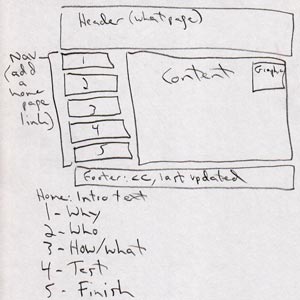Only NOW is it time for your first thoughts about content and design.
Knowing what you now know about your users and your goals for the site, you are now in a position to create a successful user interface! I would strongly suggest you begin with these considerations.
- Know your budget.
- Know your users (and know how to reach out to them; more on that in Step Four).
- Figure out what the most concise successful Web site fulfilling your needs would look like, and what it would cost you to build, in both money and time. If you find you have a surplus, decide how best to use it (or save it).
- Does the site really need to be any bigger than the most concise version you can dream up? Why? Will your goals be served any better by making the site any bigger?
- What is the user going to be trying to do on your web site? What might cause them to stumble? (You should keep this in mind AT ALL TIMES from this point forward!)
- Build a wireframe or site map and decide whether or not your site will work.
What's a wireframe?
 To the right is an example of a wireframe. This diagram could have been done using available free online tools, but in my case I simply took out a sheet of paper and a pencil, and did it by hand. You might recognize that this is the structure I chose for this Web site.
To the right is an example of a wireframe. This diagram could have been done using available free online tools, but in my case I simply took out a sheet of paper and a pencil, and did it by hand. You might recognize that this is the structure I chose for this Web site.
If you find you can't cram everything into a box on your wireframe that summarizes what is supposed to go on a page, it's probably time to re-examine what you're trying to do there, and see if your content would benefit from being trimmed or repurposed to other parts of the web site. This is a FANTASTIC time, before you even begin production, for you to be thinking about how to redesign your Web site. It's also the cheapest, simplest time to be thinking about what your future plans might be for the site, as well deciding where it might be OK to make compromises in functionality based on what you know about your user.






